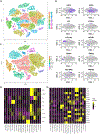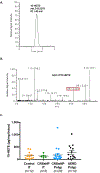Activation of the 15-lipoxygenase pathway in aspirin-exacerbated respiratory disease
- PMID: 32371071
- PMCID: PMC7606335
- DOI: 10.1016/j.jaci.2020.04.031
Activation of the 15-lipoxygenase pathway in aspirin-exacerbated respiratory disease
Abstract
Background: Aspirin-exacerbated respiratory disease (AERD) is characterized by asthma, chronic rhinosinusitis with nasal polyps (CRSwNP), and an intolerance of medications that inhibit cyclooxygenase-1. Patients with AERD have more severe upper and lower respiratory tract disease than do aspirin-tolerant patients with CRSwNP. A dysregulation in arachidonic acid metabolism is thought to contribute to the enhanced sinonasal inflammation in AERD.
Objective: Our aim was to utilize an unbiased approach investigating arachidonic acid metabolic pathways in AERD.
Methods: Single-cell RNA sequencing (10× Genomics, Pleasanton, Calif) was utilized to compare the transcriptional profile of nasal polyp (NP) cells from patients with AERD and patients with CRSwNP and map differences in the expression of select genes among identified cell types. Findings were confirmed by traditional real-time PCR. Lipid mediators in sinonasal tissue were measured by mass spectrometry. Localization of various proteins within NPs was assessed by immunofluorescence.
Results: The gene encoding for 15-lipooxygenase (15-LO), ALOX15, was significantly elevated in NPs of patients with AERD compared to NPs of patients with CRSwNP (P < .05) or controls (P < .001). ALOX15 was predominantly expressed by epithelial cells. Expression levels significantly correlated with radiographic sinus disease severity (r = 0.56; P < .001) and were associated with asthma. The level of 15-oxo-eicosatetraenoic acid (15-Oxo-ETE), a downstream product of 15-LO, was significantly elevated in NPs from patients with CRSwNP (27.93 pg/mg of tissue) and NPs from patients with AERD (61.03 pg/mg of tissue) compared to inferior turbinate tissue from controls (7.17 pg/mg of tissue [P < .001]). Hydroxyprostaglandin dehydrogenase, an enzyme required for 15-Oxo-ETE synthesis, was predominantly expressed in mast cells and localized near 15-LO+ epithelium in NPs from patients with AERD.
Conclusions: Epithelial and mast cell interactions, leading to the synthesis of 15-Oxo-ETE, may contribute to the dysregulation of arachidonic acid metabolism via the 15-LO pathway and to the enhanced sinonasal disease severity observed in AERD.
Keywords: 15-lipoxygenase; 15-oxo-eicosatetraenoic acid; AERD; ALOX15; CRSwNP; Chronic sinusitis; aspirin-exacerbated respiratory disease; hydroxyprostaglandin dehydrogenase; nasal polyps.
Copyright © 2020 American Academy of Allergy, Asthma & Immunology. Published by Elsevier Inc. All rights reserved.
Conflict of interest statement
Conflicts of Interest:
RC, DC, KH, JH, JN, CP, AS, SS, LS, DW, and KW reports no conflicts of interest. WS served on an advisory board for GlaxoSmithKline. AK reports personal fees from Astellas Pharmaceuticals. BT reports personal fees from Sanofi Regeneron/Genzyme, and OptiNose. AP reports personal fees from Sanofi Regeneron and personal fees and grants from AstraZeneca. LG reports personal fees from Astellas Pharmaceuticals. RK reports personal fees from Sanofi, Novartis, Lyra Pharmaceutical, and Neurent. RS reports personal fees from Intersect ENT, Merck, GlaxoSmithKline, Sanofi, AstraZeneca/Medimmune, Genentech, Actobio Therapeutics, Lyra Therapeutics, Astellas Pharma Inc., and Otsuka Inc. RS also has Siglec-8 and Siglec-8 ligand related patents licensed to Allakos Inc.
Figures







Comment in
-
Eicosanoid relay: Epithelial and mast cell transmetabolism in AERD.J Allergy Clin Immunol. 2021 Feb;147(2):501-503. doi: 10.1016/j.jaci.2020.12.627. J Allergy Clin Immunol. 2021. PMID: 33358894 No abstract available.
Similar articles
-
Nasal polyp antibody-secreting cells display proliferation signature in aspirin-exacerbated respiratory disease.J Allergy Clin Immunol. 2024 Feb;153(2):527-532. doi: 10.1016/j.jaci.2023.10.011. Epub 2023 Oct 28. J Allergy Clin Immunol. 2024. PMID: 37898408 Free PMC article.
-
Studies of the role of basophils in aspirin-exacerbated respiratory disease pathogenesis.J Allergy Clin Immunol. 2021 Aug;148(2):439-449.e5. doi: 10.1016/j.jaci.2021.02.045. Epub 2021 Apr 2. J Allergy Clin Immunol. 2021. PMID: 33819512 Free PMC article. Clinical Trial.
-
Cytokines in Chronic Rhinosinusitis. Role in Eosinophilia and Aspirin-exacerbated Respiratory Disease.Am J Respir Crit Care Med. 2015 Sep 15;192(6):682-94. doi: 10.1164/rccm.201412-2278OC. Am J Respir Crit Care Med. 2015. PMID: 26067893 Free PMC article.
-
New concepts for the pathogenesis and management of aspirin-exacerbated respiratory disease.Curr Opin Allergy Clin Immunol. 2022 Feb 1;22(1):42-48. doi: 10.1097/ACI.0000000000000795. Curr Opin Allergy Clin Immunol. 2022. PMID: 34739410 Free PMC article. Review.
-
Aspirin-Exacerbated Respiratory Disease as an Endotype of Chronic Rhinosinusitis.Immunol Allergy Clin North Am. 2016 Nov;36(4):669-680. doi: 10.1016/j.iac.2016.06.004. Epub 2016 Sep 13. Immunol Allergy Clin North Am. 2016. PMID: 27712762 Free PMC article. Review.
Cited by
-
The role of 15 lipoxygenase 1 in asthma comes into focus.J Clin Invest. 2022 Jan 4;132(1):e155884. doi: 10.1172/JCI155884. J Clin Invest. 2022. PMID: 34981786 Free PMC article.
-
Single cell RNA sequencing of human eosinophils from nasal polyps reveals eosinophil heterogeneity in chronic rhinosinusitis tissue.J Allergy Clin Immunol. 2024 Oct;154(4):952-964. doi: 10.1016/j.jaci.2024.05.014. Epub 2024 May 24. J Allergy Clin Immunol. 2024. PMID: 38797240
-
Comprehensive time-course gene expression evaluation of high-risk beef cattle to establish immunological characteristics associated with undifferentiated bovine respiratory disease.Front Immunol. 2024 Sep 13;15:1412766. doi: 10.3389/fimmu.2024.1412766. eCollection 2024. Front Immunol. 2024. PMID: 39346910 Free PMC article.
-
Updates on the Natural History and Clinical Characteristics of NSAID-ERD.J Allergy Clin Immunol Pract. 2024 Nov;12(11):2889-2896. doi: 10.1016/j.jaip.2024.07.013. Epub 2024 Jul 20. J Allergy Clin Immunol Pract. 2024. PMID: 39038540 Review.
-
Epithelial dysregulation in chronic rhinosinusitis with nasal polyposis (CRSwNP) and aspirin-exacerbated respiratory disease (AERD).J Allergy Clin Immunol. 2021 Nov;148(5):1161-1164. doi: 10.1016/j.jaci.2021.07.034. Epub 2021 Aug 6. J Allergy Clin Immunol. 2021. PMID: 34371082 Free PMC article. No abstract available.
References
-
- Rajan JP, Wineinger NE, Stevenson DD, White AA. Prevalence of aspirin-exacerbated respiratory disease among asthmatic patients: A meta-analysis of the literature. J Allergy Clin Immunol 2015; 135:676–81 e1. - PubMed
-
- Batra PS, Tong L, Citardi MJ. Analysis of comorbidities and objective parameters in refractory chronic rhinosinusitis. Laryngoscope 2013; 123 Suppl 7:S1–11. - PubMed
Publication types
MeSH terms
Substances
Grants and funding
LinkOut - more resources
Full Text Sources
Other Literature Sources
Miscellaneous

